Display products with variants
Products with variants are displayed in the grid, they can be managed and enriched in the same way as other products.
Thanks to the variant display option, you can choose how your product models/variant products appear in the product grid. You have two options: variant: grouped and variant: ungrouped.
When selecting grouped, product models and simple products are displayed in the grid.
When selecting ungrouped, variant products and simple products are displayed in the grid. This view can be very useful to mass edit products, as you can directly select the variant products you need to work on.
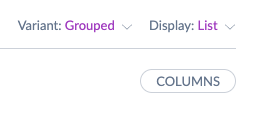
To recognize a product model in the grid, it's displayed with a pile of pictures which means that some variant products are behind this model.
A product model has no completeness, but you can follow the completeness of its variant products in the Variant products column in the grid, with:
- 1st number: the number of complete variant products for this product model
- 2nd number: the total number of variant products behind this product model
For example, on the 1st product model, 2 variant products are complete out of the 6 variant products.
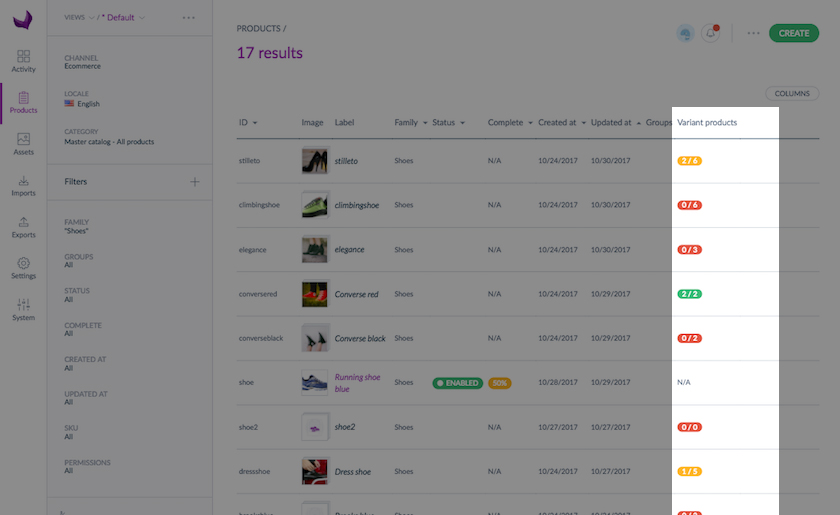
If the background of the Variant products is:
- Red: all products of the product model are incomplete
- Yellow: at least one product of the product model is complete
- Green: all products of the product model are complete
Search for products with variants
Filter on product typology
You can filter on product typology in order to display only the simple products or only the variant products in the grid.
It can be very useful if you have to mass edit different variant products in different product models, for instance.
You can combine this product typology filter with the Variant: Grouped display option of the grid.
Let's take an example: you need to work on variant products only (not simple products, not product models). You can easily display them by using the product typology filter (filtering on Variant) plus by setting the Variant display option to Ungrouped.
Filter on the identifier
You can filter your products/product models on their identifier. This filter enables you to easily and quickly search for several product models for instance.
Filter on your attributes
To easily manage up to 3 levels of enrichment for the products with variants, we added a smart search in the grid to automatically display what you are looking for. Either a product model, or a product.
By default, if no filter in the grid, the products are grouped by product models, so the product models are displayed in the grid.
Let's take an example with a t-shirt model model-tshirt-divided with 2 variant levels, available in 3 colors (blue, red, grey) and each color is available in 4 different sizes (S, M, L, XL). When you open the grid, one line for this t-shirt model is displayed (12 variant products are grouped in this product model).

As done on e-commerce websites, if you are looking for clothes with the color "red", red clothes will be automatically displayed in the grid.
So in our example, you add the filter on the color attribute and select the red option, the model-tshirt-divided-red sub product model is displayed in the grid (with 4 red variant products in S, M, L, XL sizes).
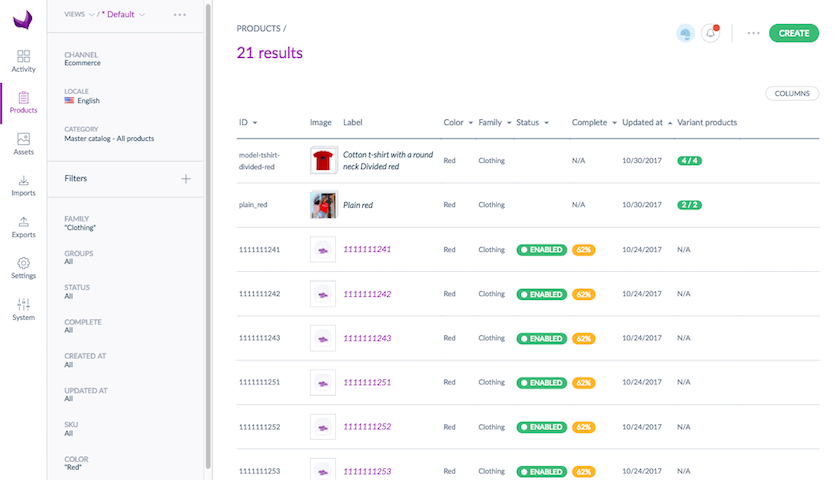
If you are looking for clothes with the red color and the S size, red clothes with the S size will be displayed in the grid.
So in our example, you keep the filter on the color attribute with the red option and you add a filter on the attribute size and select the S option. For this t-shirt model, only one product has the color red and the size S, so the tshirt-divided-red-s variant product is displayed in the grid with its completeness.
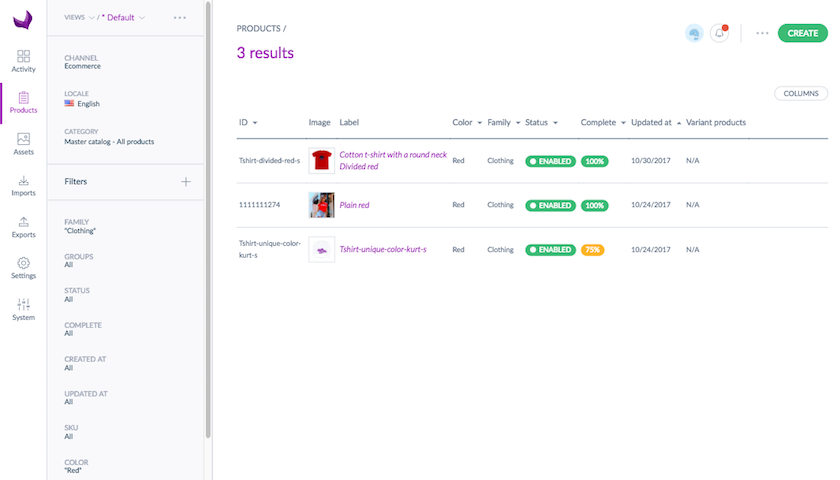
Filter on the categories
If you search by categories, the grid will automatically display the product models or the products classified according to the category selected in the grid.
If a product model is not classified in the selected category but its children products are, the products will be displayed in the grid. So all the filters, attributes and categories selected in the grid, will be taken into account to display the level you would like to enrich. Either a product model, or a product.
For more details about the classification of products with variants, please read this paragraph in the article.
Let's take again our previous example, the t-shirt model "Model-tshirt-divided" is classified in the T-shirts category, its color red is classified in the Christmas category and the products with the sizes S (red S, blue S, grey S) are classified in the Small category.
If you click on the T-shirts category, the Model-tshirt-divided product model is displayed in the grid.
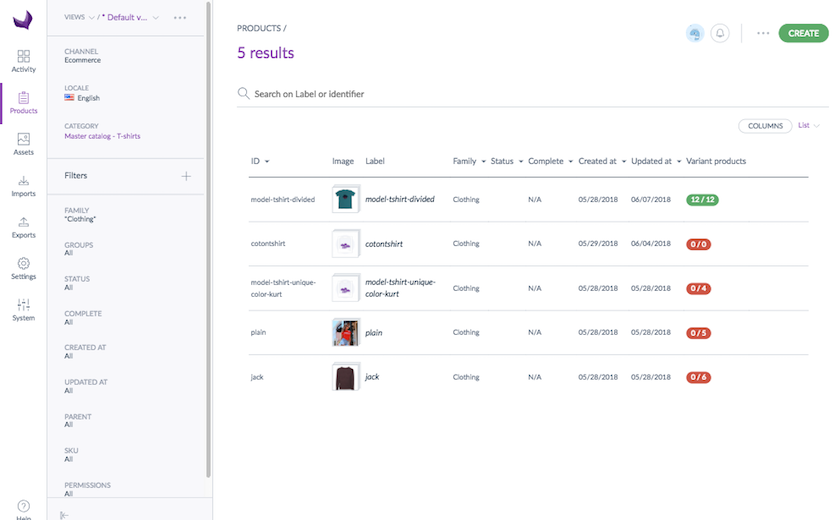
If you click on the Christmas category, the sub product model "model-tshirt-divided-red" is displayed in the grid (same result for this t-shirt model than if you click on the T-shirts category and filter on the attribute color and the option red).
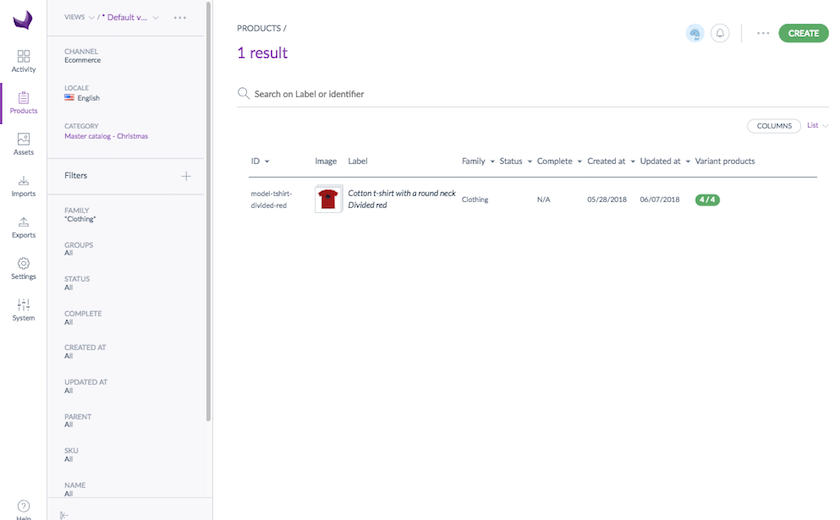
If you click on the Small category, the products of this product model with the sizes S are displayed in the grid (same results for this t-shirt model than if you click on the T-shirts category and filter on the attribute size and the option S).
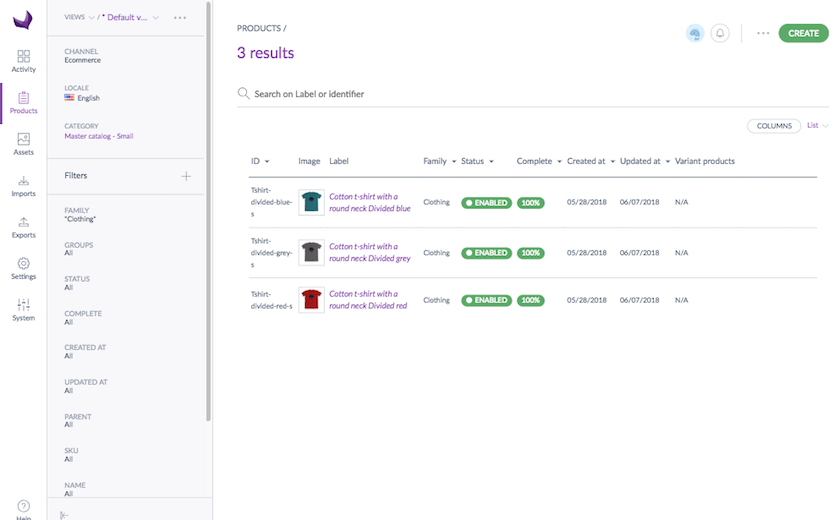
Filter on the completeness
A product model has no completeness but its variant products have a completeness.
For the completeness filter Complete:
- If you select Yes, the product models with at least one variant product complete are displayed in the grid
- If you select No, the product models with at least one variant product incomplete are displayed in the grid
- If you select All, there is no filter on the completeness
Filter on the parent product model
To display the children of a product model, you can filter on the parent attribute in the product grid with the product model code.
You can also add a parent column in the grid to display the parent product model code. This column is not displayed by default, you can add it by clicking on Columns.
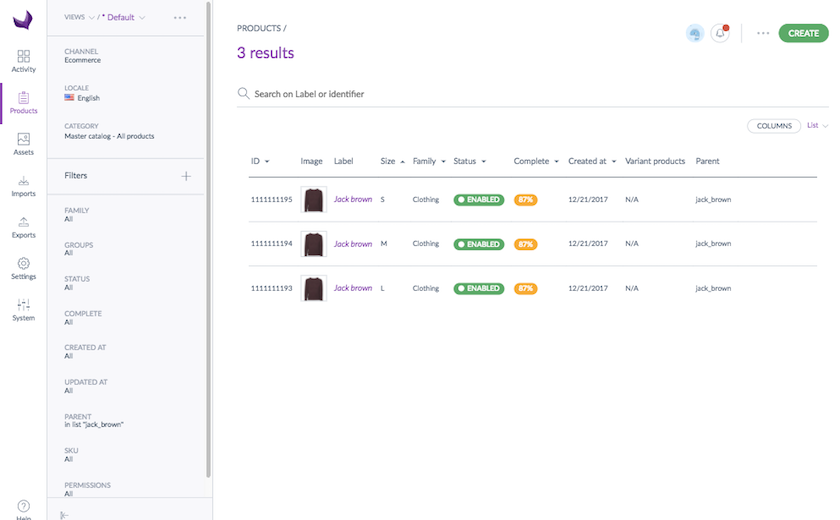
Edit products with variants
Click on a product model on the grid or create a new product model to display the product form for products with variants.
The products with variants are enriched in the same product form than products without any variant.
For more details about the product form, you can read Enrich your product.
Header and infos
For product models, the following properties are displayed in the product form header:
- The number of complete variant products out of the number of variant products for a product model in Variant products (ex: 2/6 means that 2 variants out of 6 for the product model are complete)
- The total missing required attributes for a product model. If you click on it, it displays only the attributes that are required for the completeness but that are still incomplete (it filters on display All missing required attributes).
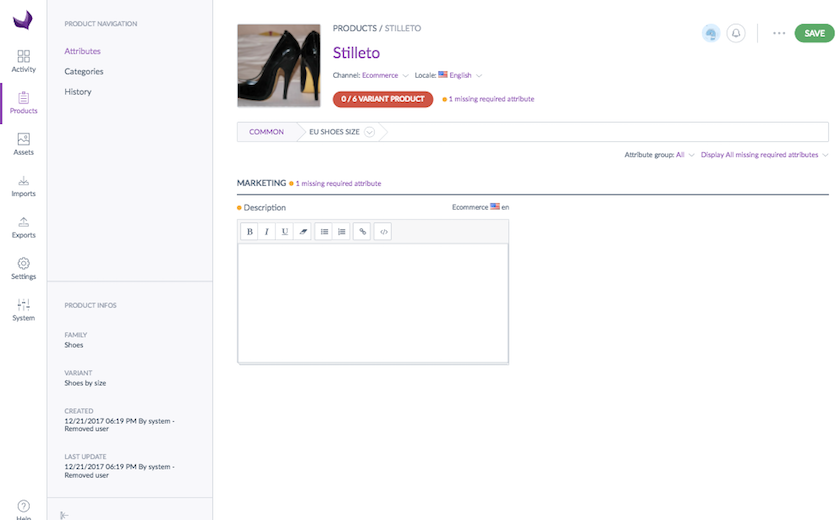
For product models, the following properties are displayed in the Product infos:
- Family: All the products of a product model belong to the same family
- Variant: A family variant defines how the products with variants are structured
- Created: Creation date and user who create the product model
- Last update: Updated date and user who last update the product model
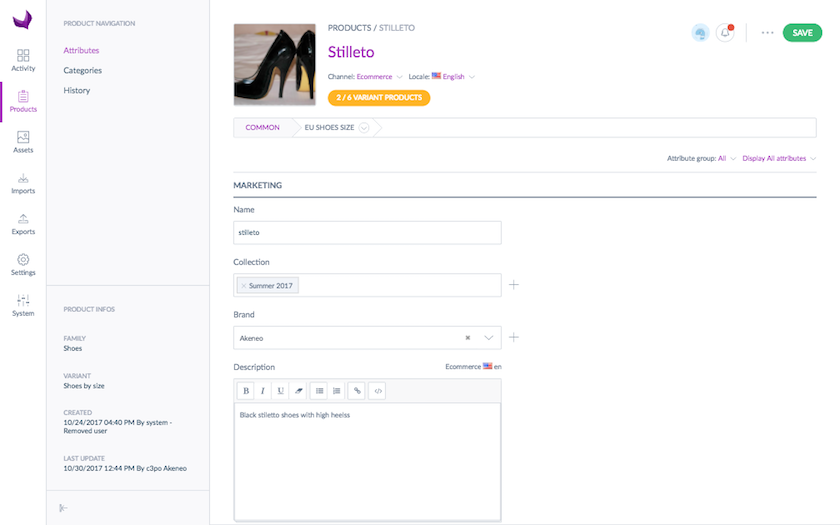
Navigate among your products with variants
The product form for products with variants has a navigation component to navigate among your products with variants structure and display the different variant levels.
You can enrich easily the common properties or the specific properties for a variant level.
This navigation component is composed of:
- COMMON: you can enrich the common properties for all the products of this model
- Variant axes labels level 1: you can enrich the properties which vary according to the variant axes level 1 of this model (COLOR in our example)
-
Variant axes labels level 2: if your family variant has 2 variant levels, you can enrich the properties which vary for each product of this model (SIZE in our example)
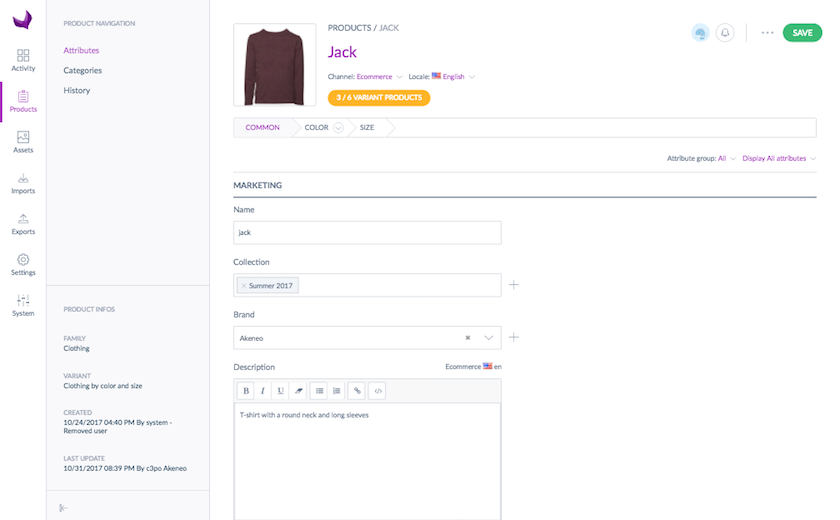
- Click on the small arrow next to the Variant axes labels level 1 to display the values available for this product model (COLOR in our example)
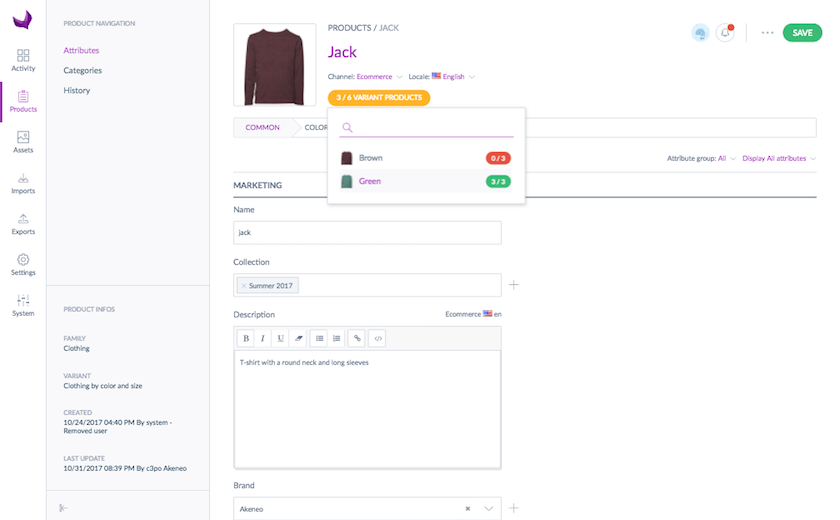
- Click on a line to reload the product form with the properties of the variant axes values selected
- Click on the small arrow next to the Variant axes labels level 2 to display the values available for this sub product model (SIZE in our example)
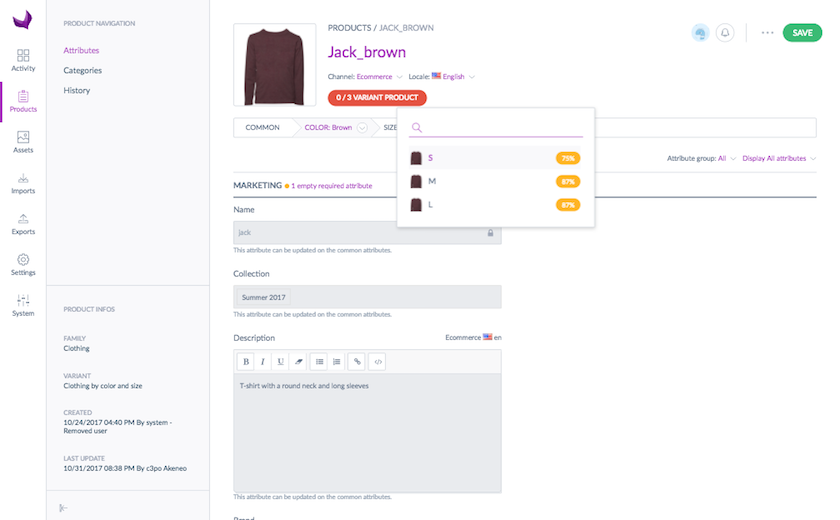
- Click on a line to reload the product form with the properties of the variant axes values selected
- Click on the small arrow next to the Variant axes labels level 1 to display the values available for this product model (COLOR in our example)
In the navigation component, you can also view the number of variant products complete for a product model or the completeness of the product if it's the last variant level (product level).
We manage the following common properties for products with variants:
- Attributes
- Categories
Enrich their attributes
In COMMON, in the Attributes tab, you can enrich the common attributes for the products of this product model (the common attributes are defined in the family variant).
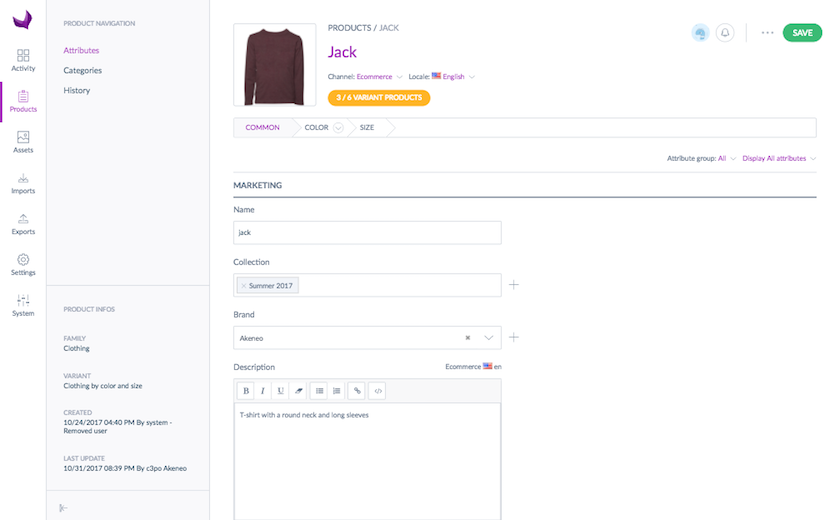
In a variant level, you can view the common attributes but you can not update them. If you would like to update them, go in COMMON (message This attribute can be updated on the common attributes) or in the dedicated level (message example This attribute can be updated on the attributes by Color).
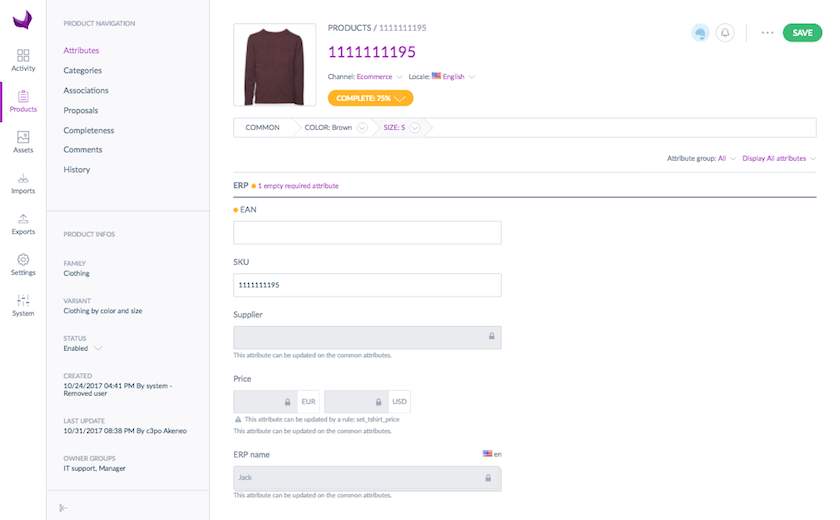
In the product form there is a filter called Display all level specific attributes to display only the attributes managed at the current level that can be enriched. This is very easy: just click on the drop down Display all attributes and select Display all level specific attributes. That's it! This filter is available only for variant products and sub product models (if family variant with 2 variant levels).
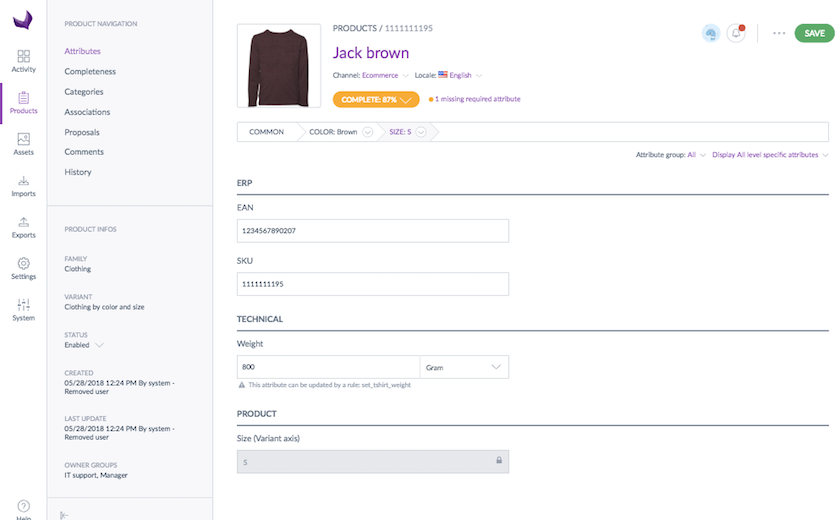
Categorize
In COMMON, in the Categories tab, you can classify the model and all its children products in categories.
You can then add categories for a specific variant level. For example, your model is categorized in T-shirts and for the color blue, you can add them to a dedicated category Marine.
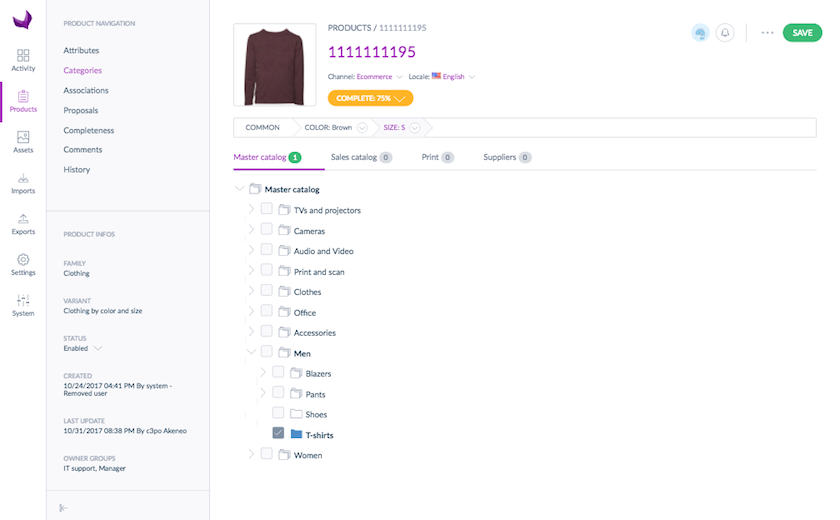
You can add categories on the products for this product model but on a product you can not remove a category of its parent, the category is disabled in the tree. If you would like to remove it, go in COMMON or in the dedicated level.
Associate
In COMMON, in the Associations tab, you can define associations for the whole product model and all its children products will be also associated.
For example, you can define associations for this t-shirt model.
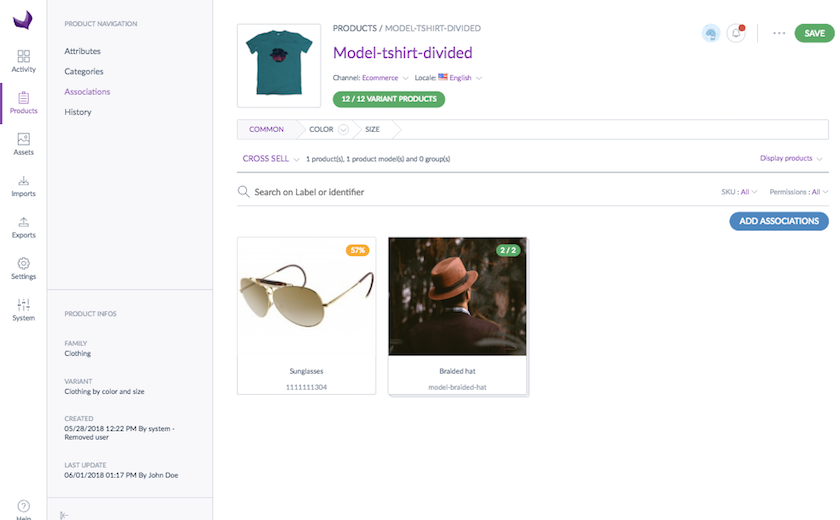
You can also add associations for a specific variant level. For example, you define an association only for the Red color.
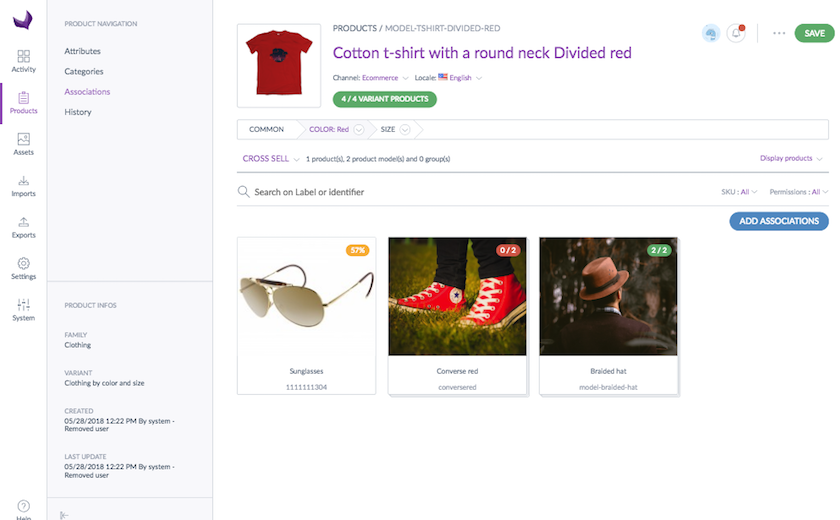
The products will have all the associations of their parents. Hereafter the associations for the Red S t-shirt.
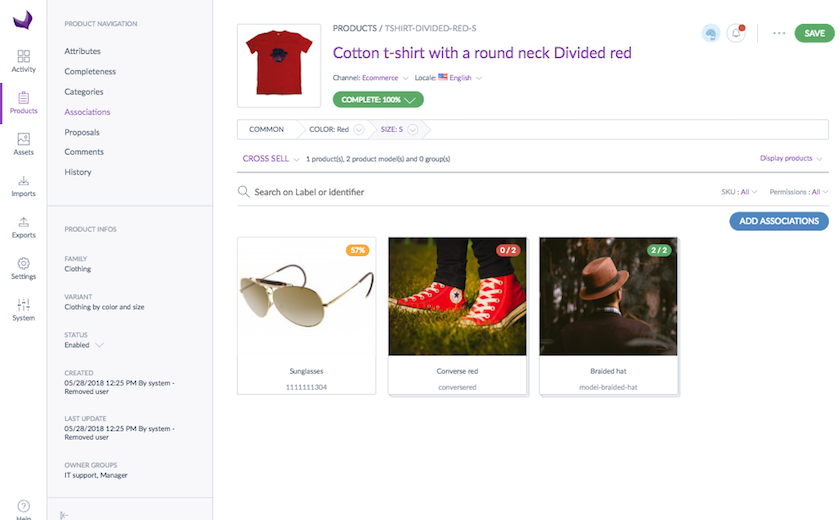
You can add associations on the products for this product model but on a product you can not remove an association of its parent. If you would like to remove it, go in COMMON or in the dedicated level.
Associate with quantities
If you created an association type with quantities, it is possible to create a product set based on a product model with different quantities between the product model and its product variants. In that case, a message in the helper section will give you a synchronization warning.
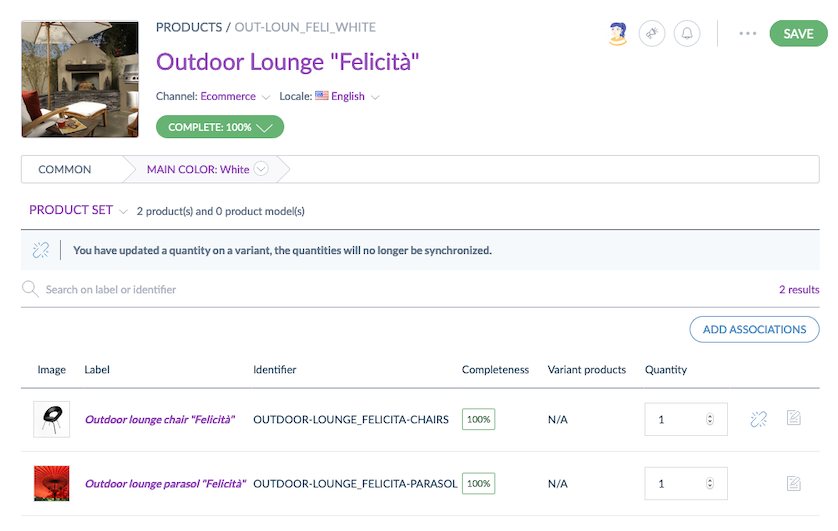
Please read our Association types documentation for more information.
Add a variant
You can add a variant to a product model from the product form via the navigation component. In our example, click on the EU Shoes Size tab nearby Common.
- In the navigation component EU Shoes Size, click on the Add new button, a pop-in is displayed
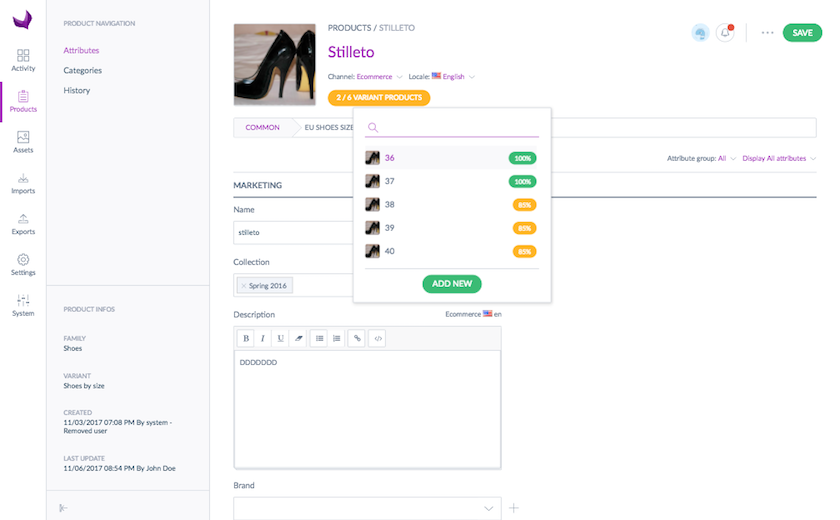
- Select or enter the values for the variant axes
- Specify a product model code or a product identifier depending on the variant level
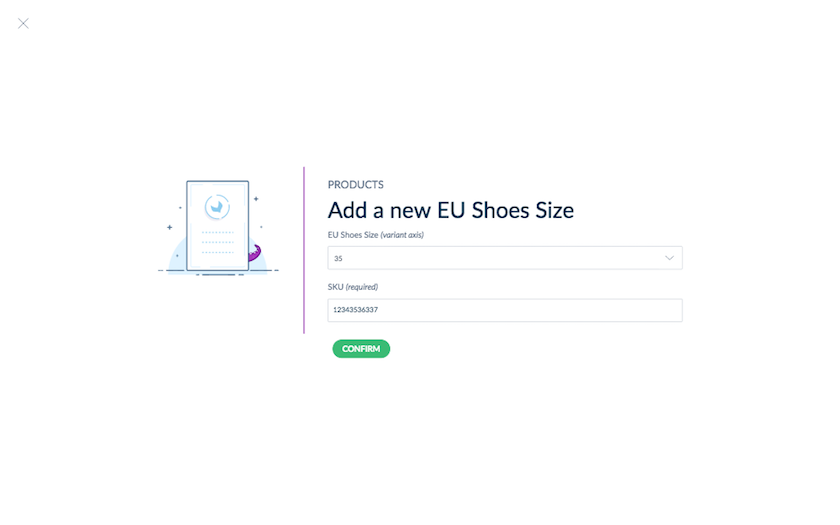
- Click on Confirm
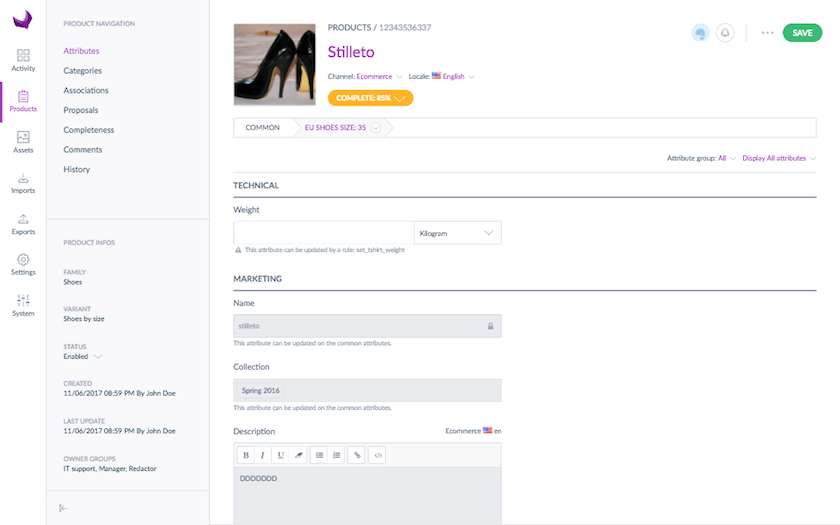
The variant is added to the product model and its form is displayed, you can start filling its attributes.
If the family variant has 2 variant levels (for example by color then by size), you can add a variant COLOR at the 1st variant level as a product model (with a code) or you can also add a variant SIZE to a COLOR at the 2nd variant level as a variant product (with a product identifier).
In the Enterprise Edition, the ADD NEW button will not be displayed, if the user has no edit permissions on the attribute group of the product identifier attribute.
View their history
For each change, a new version is created. What is tracked down for each version:
- The author or system that made the changes
- The date and time (up to seconds) at which the changes took place
- The old and the new value of each amended product information
The list of versions are displayed in the History tab.
In COMMON, only the common properties (attributes and categories) will be versioned. You can use the navigation component to display the versions of each variant level.
Move a Product Model to a New Family or Family Variant
You can change the family variant of a product model using the dedicated import profile: "Move product model family in CSV."
Steps to Move a Product Model
To move a product model to a new family or family variant, your CSV import file must include two columns:
-
code: The code of the product model you want to move. -
family_variant: The code of the family variant where you want to move the product model.
All sub-product models and variant products linked to the root product model will also be moved to the new family variant.
Simplifying the Process
To make the import process easier, you can follow these steps:
- Export the product models you wish to move using a Quick Export or Classic Export.
- Update the family variants in the exported file.
- Import the updated file using the dedicated import profile.
Note: You cannot move product models to a new family variant using the 'Classic' product model import profile.
Constraints
You can only move product models if the following conditions are met:
- Matching Levels: The origin and destination family variants must have the same number of levels.
- Consistent Variant Axes: The origin and destination family variants must use the same attributes as variant axes.
- Attribute Levels: Attributes must be at the same level in both the origin and destination family variants (e.g., if the product description is at the variant level in the origin, it must remain at the variant level in the destination).
Convert a variant product to a simple one
Sometimes, you may need to convert a variant product to a simple product, for instance when there is a reduction of your product range. To do so, several choices:
- directly in a variant product sheet
- via a bulk action
- via a product import
- via the API
Let's see how each of these solutions works!
No matter the way you do the conversion, your variant product becomes a simple product but don't worry, all of its former values, categories and associations will be saved.
Convert a variant product to a simple one via a unitary action
When you are on a product page, at the variant level, you can decide to convert it to a simple product very easily.
- Click on …
- Then Convert to a simple product
- Confirm

Convert variant products to a simple ones via a bulk action
When selecting one or several product models or variant products, you can launch a bulk action in order to convert all these variants to simple products.
- Select one or several product models or variant products in the grid
- Click on Bulk actions
- Then select Convert to simple products
- Confirm your action
All the variants of your selection will be then converted to simple products, meaning that they won't be attached to a parent anymore.
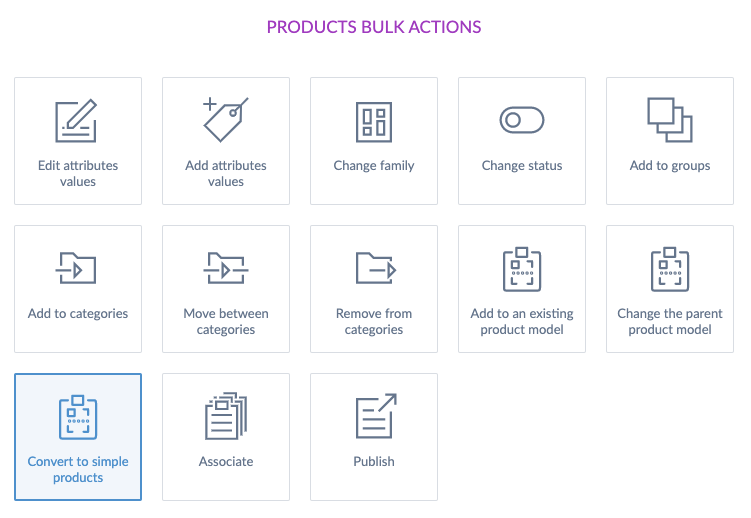
Convert variant products to simple ones via an import
It is also possible to convert a variant product to a simple one by import, by removing its parent.
- Go to the Global settings tab of your product import job profile
- Scroll down until the Convert variant products to simple products parameter. By default, it is set to No. It means that the PIM won't convert your variant products if the parent column is empty in your xlsx/csv file. If this option is set to Yes, then the PIM will convert all the variant products with an empty parent column.

Convert variant products to simple ones via the API
Please refer to our API documentation to discover how to convert variant products to simple ones via the API.
Delete a product model
You can delete a product model from the product grid or the product form.
From the product grid
- Hover your mouse over the product model line in the grid, then the delete button (a trash icon) will be displayed
- Click on the Delete button
- A confirmation pop-in opens
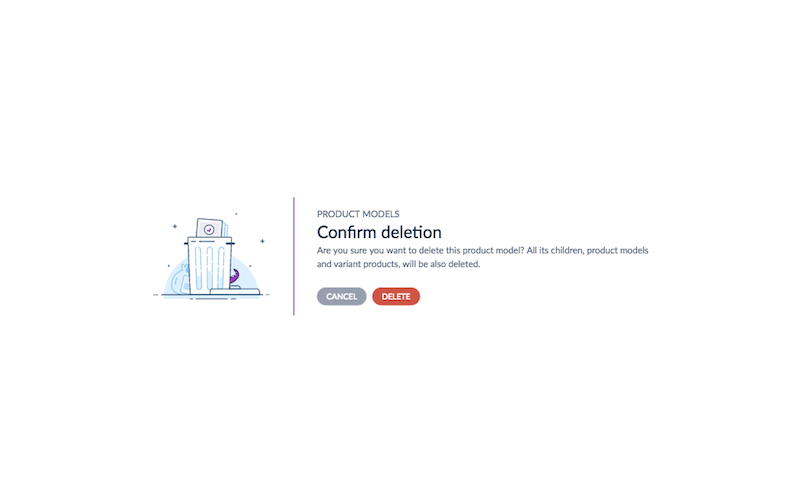
- Then click on Delete to confirm you want to delete the product model and its children
The product model and all its children (product models and variant products) are deleted.
You can also mass delete product models. If you delete product models, all their children (sub product models if any and their variant products) will also be deleted.
From the product form
- Open the product form for a product model
- Click on the ... in the top right corner of the screen
- Select Delete in the dropdown
- A confirmation pop-in opens
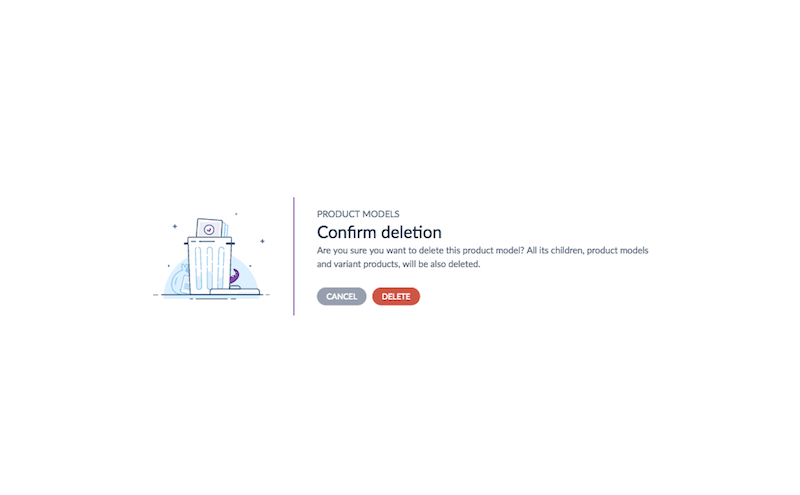
- Then click on Delete to confirm you want to delete the product model and its children
The product model and all its children (product models and variant products) are deleted.


